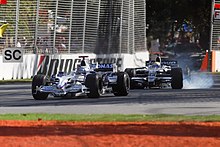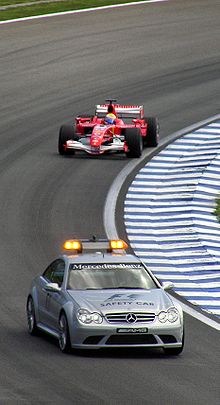Racing and strategy
Qualifying
The current qualifying system was adopted for the 2006 season. Known as "knock-out" qualifying, it is split into three periods (or rounds). In each period, drivers run qualifying laps to attempt to advance to the next period, running as many laps as they wish, with the slowest drivers being "knocked out" at the end of the period and their grid positions set, based on their best lap times. Cars are eliminated in this manner until 10 cars remain eligible to attempt to qualify for pole position in the third and final period. For each period, all previous times are reset, and only a driver's fastest lap in that period (barring infractions) counts. For all periods, any timed lap started before the chequered flag falls signalling the end of that period may be completed, and will count toward that driver's placement, even if they cross the finish line after the period has ended. In the first two periods, cars may run any tyre compound they wish, and drivers eliminated in these periods are allowed to change their choice of tyres prior to the race. Cars taking part in the final period, however, must start the race with the tyres used during their fastest lap (exactly the same tyres, not just the same compound), barring changes in weather that require usage of wet-weather tyres. With refuelling not allowed during races from 2010, the final session is run with low-fuel configuration and the cars are refuelled after qualifying.
For example, for a 20-car grid, all 20 cars are permitted to take part in the first period. At the end of the period, the slowest five cars are eliminated and take up the last five grid positions (16 to 20). In the second period, the remaining fifteen cars take part, with five more cars eliminated at the end, taking the next five lowest grid positions (11 to 15). In the third and final period, the remaining 10 cars compete for pole position, and fill grid positions 1 through 10.
The knock-out format has received minor updates since its inception, such as adjustments to the number of drivers eliminated in each period as the total number of cars entered has changed (from 20 drivers in 2009 to 24 in 2010).
The race
The race begins with a warm-up lap, after which the cars assemble on the starting grid in the order they qualified. This lap is often referred to as the formation lap, as the cars lap in formation with no overtaking (although a driver who makes a mistake may regain lost ground provided he has not fallen to the back of the field). The warm-up lap allows drivers to check the condition of the track and their car, gives the tyres a chance to get some heat in them to get some much-needed traction, and gives the pit crews time to clear themselves and their equipment from the grid.Once all the cars have formed on the grid, a light system above the track indicates the start of the race: five red lights are illuminated at intervals of one second; they are all then extinguished simultaneously after an unspecified time (typically less than 3 seconds) to signal the start of the race. The start procedure may be abandoned if a driver stalls on the grid, signalled by raising his arm. If this happens the procedure restarts: a new formation lap begins with the offending car removed from the grid. The race may also be restarted in the event of a serious accident or dangerous conditions, with the original start voided. The race may be started from behind the Safety Car if officials feel a racing start would be excessively dangerous, such as extremely heavy rainfall. There is no formation lap when races start behind the Safety Car.
Under normal circumstances the winner of the race is the first driver to cross the finish line having completed a set number of laps, which added together should give a distance of approximately 305 km (190 mi) (260 km (160 mi) for Monaco). Race officials may end the race early (putting out a red flag) due to unsafe conditions such as extreme rainfall, and it must finish within two hours, although races are only likely to last this long in the case of extreme weather. Drivers may overtake one another for position over the course of the race and are 'Classified' in the order they finished the race. If a leader comes across a back marker (slower car) who has completed fewer laps, the back marker is shown a blue flag telling him he is obliged to allow the leader to overtake him. The slower car is said to be 'lapped' and, once the leader finishes the race, is classified as finishing the race 'one lap down'. A driver can be lapped numerous times, by any car in front of him. A driver who fails to finish a race, through mechanical problems, accident, or any other reason is said to have retired from the race and is 'Not Classified' in the results. However, if driver has completed more than 90% of the race distance, he will be classified.
- Race director
- As of 2010 the race director in Formula One is Charlie Whiting. This role involves him generally managing the logistics of each F1 Grand Prix, inspecting cars in Parc fermé before a race, enforcing FIA rules and controlling the lights which start each race. As the head of the race officials he also plays a large role in sorting disputes amongst teams and drivers. Penalties, such as drive-through penalties (and stop-and-go penalties), demotions on a pre-race start grid, race disqualifications, and fines can all be handed out should parties break regulations.
- Safety car
- In the event of an incident that risks the safety of competitors or trackside race marshals, race officials may choose to deploy the safety car. This in effect suspends the race, with drivers following the safety car around the track at its speed in race order, with overtaking not permitted. The safety car circulates until the danger is cleared; after it comes in the race restarts with a 'rolling start'. Pit stops are permitted under the safety car. Mercedes-Benz supplies Mercedes-AMG models to Formula One to use as the safety cars. Since 2000, the main safety car driver has been German ex-racing driver Bernd Mayländer. On the lap in which the safety car returns back into the pits the leading car takes over the role of the safety car until the first safety car line, which is usually a white line after the pit lane entrance. After crossing this line drivers are allowed to start racing for track position once more.
- Red flag
- In the event of a major incident or unsafe weather conditions, the race may be red-flagged. Then:
- If under 3 laps have been completed when the red flag is displayed, the race is restarted from original grid positions. All drivers may restart, provided their car is in a fit state to do so.
- If between 3 laps and 75% of the race distance have been completed, the race may be restarted once it is safe to do so, maintaining the race order at the time of the red flag. The two-hour time limit still applies and the clock does not stop.
- If more than 75% of the race distance has been completed then the race is terminated and the race result counted back to the second last completed lap before the red flag.




0 comments:
Post a Comment